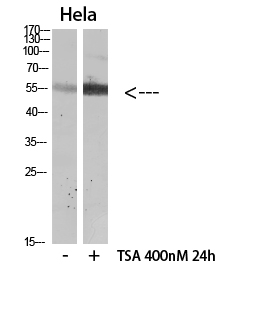产品名称
HNF-4α (Acetyl Lys106) Rabbit Polyclonal Antibody
别名
Hepatocyte nuclear factor 4-alpha (HNF-4-alpha) (Nuclear receptor subfamily 2 group A member 1) (Transcription factor 14) (TCF-14) (Transcription factor HNF-4)
基因名称
HNF4A HNF4 NR2A1 TCF14
蛋白名称
Hepatocyte nuclear factor 4-alpha (HNF-4-alpha) (Nuclear receptor subfamily 2 group A member 1) (Transcription factor 14) (TCF-14) (Transcription factor HNF-4)
存储缓冲液
Liquid in PBS containing 50% glycerol, 0.5% BSA and 0.02% New type preservative N.
Human Gene Link
http://www.ncbi.nlm.nih.gov/sites/entrez?db=gene&term=3172
Human Swissprot No.
P41235
Human Swissprot Link
http://www.uniprot.org/uniprotkb/P41235/entry
Mouse Swissprot No.
P49698
Mouse Swissprot Link
http://www.uniprot.org/uniprot/P49698
Rat Swissprot Link
http://www.uniprot.org/uniprot/O54941P22449
免疫原
Synthetic Acetyl peptide from human protein at AA range: 106
特异性
The antibody detects endogenous HNF-4α when Acetyl occurs at Lys106
稀释度
WB 1:500-2000, ELISA 1:10000-20000
宿主
Polyclonal, Rabbit,IgG
背景介绍
The protein encoded by this gene is a nuclear transcription factor which binds DNA as a homodimer. The encoded protein controls the expression of several genes, including hepatocyte nuclear factor 1 alpha, a transcription factor which regulates the expression of several hepatic genes. This gene may play a role in development of the liver, kidney, and intestines. Mutations in this gene have been associated with monogenic autosomal dominant non-insulin-dependent diabetes mellitus type I. Alternative splicing of this gene results in multiple transcript variants encoding several different isoforms. [provided by RefSeq, Apr 2012],
信号通路
Maturity onset diabetes of the young;
功能
alternative products:Additional isoforms seem to exist,disease:Defects in HNF4A are the cause of maturity onset diabetes of the young type 1 (MODY1) [MIM:125850]; also shortened MODY-1. MODY [MIM:606391] is a form of diabetes that is characterized by an autosomal dominant mode of inheritance, onset in childhood or early adulthood (usually before 25 years of age) and a primary defect in insulin secretion. The clinical phenotype of MODY1 is characterized by severe insulin secretory defects, and by major hyperglycemia associated with microvascular complications.,function:Transcriptionally controlled transcription factor. Binds to DNA sites required for the transcription of alpha 1-antitrypsin, apolipoprotein CIII, transthyretin genes and HNF1-alpha. May be essential for development of the liver, kidney and intestine.,miscellaneous:Binds fatty acids.,online information:Hepatocyte nuclear factors entry,PTM:Phosphorylated on tyrosine residue(s); phosphorylation is important for its DNA-binding activity. Phosphorylation may directly or indirectly play a regulatory role in the subnuclear distribution.,similarity:Belongs to the nuclear hormone receptor family.,similarity:Belongs to the nuclear hormone receptor family. NR2 subfamily.,similarity:Contains 1 nuclear receptor DNA-binding domain.,subunit:Homodimerization is required for HNF4-alpha to bind to its recognition site.,
纯化
The antibody was affinity-purified from rabbit antiserum by affinity-chromatography using epitope-specific immunogen.

